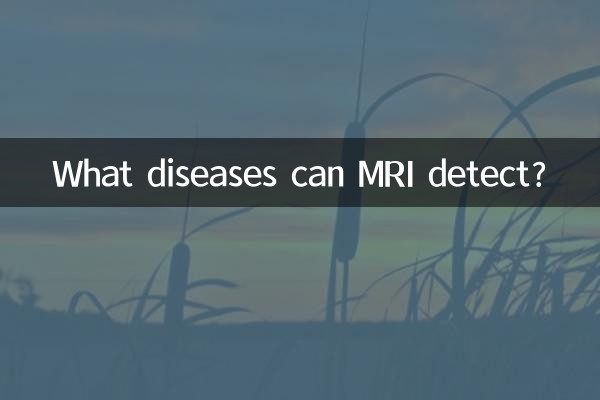What diseases can MRI detect?
Magnetic resonance imaging (MRI) is a medical examination technology that uses magnetic fields and radio waves to produce detailed images of the inside of the human body. Due to its non-radiation and high resolution, MRI is widely used in clinical diagnosis. This article will introduce in detail the types of diseases that MRI can detect and display relevant information through structured data.
1. Common diseases examined by MRI

MRI can be used to examine a variety of diseases, covering the nervous system, musculoskeletal system, cardiovascular system and other fields. The following are common MRI examination ranges:
| Disease category | specific disease | Advantages of MRI |
|---|---|---|
| neurological diseases | Brain tumors, stroke, multiple sclerosis | High-resolution visualization of brain tissue structures and lesions |
| Musculoskeletal system diseases | Joint injuries, torn ligaments, herniated discs | Clear visualization of soft tissue lesions |
| cardiovascular disease | Cardiomyopathy, cardiac tumors, vascular malformations | Non-invasive examination of cardiac structure and function |
| abdominal disease | Liver tumors, pancreatitis, kidney disease | Multi-plane imaging for easy diagnosis |
2. Contraindications of MRI examination
Although MRI is a safe test, not everyone is suitable for MRI. The following are contraindications to MRI examination:
| Types of contraindications | Specific content |
|---|---|
| Absolute contraindications | Have metal implants in the body (such as pacemakers, metal clips, etc.) |
| Relative contraindications | Early pregnancy, claustrophobia, severe renal insufficiency |
3. Comparison between MRI and other imaging examinations
MRI has unique advantages and limitations compared with other imaging examination methods such as CT and X-ray. Here's how MRI compares to other examination methods:
| Check method | Advantages | limitations |
|---|---|---|
| MRI | No radiation, high soft tissue resolution | Inspections take a long time and are expensive |
| CT | Fast inspection and clear bone imaging | Radiation, soft tissue resolution is low |
| X-ray | Easy to operate and low cost | There is radiation and can only display two-dimensional images. |
4. Precautions for MRI examination
Before undergoing an MRI examination, patients need to pay attention to the following:
| Before inspection | Under inspection | After inspection |
|---|---|---|
| Remove all metal items | stay still | No special care required |
| Tell your doctor about implants | Follow breathing instructions | Waiting for test results |
5. Summary
MRI, as an advanced imaging technology, can help doctors diagnose a variety of diseases, especially soft tissue lesions. Although MRI examination has certain contraindications and limitations, its radiation-free and high-resolution features make it the preferred method for diagnosing many diseases. Patients should fully understand the relevant precautions before undergoing MRI examination to ensure that the examination proceeds smoothly.
With the continuous development of medical technology, the application scope of MRI will be further expanded, providing strong support for the early diagnosis and treatment of more diseases.

check the details

check the details